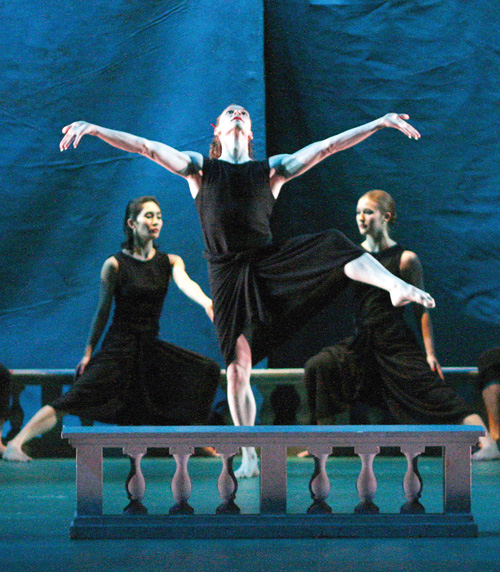arts@sfbg.com
DANCE What makes watching the Mark Morris Dance Group’s Dido and Aeneas such a satisfying — and ultimately profound — experience? It’s really simple: give a story of love and war to a poet, who creates a rhythmically and imagistically suggestive libretto, which then gets into the hands of a genius composer, and finally ends up with Mark Morris, who just happens to be a great choreographer and company director. That’s it.
Morris created Dido in Brussels in 1989, where the Opera de la Monnaie had everything he needed: a budget for production, support for a large group of dancers, and the freedom do what he wanted. That experience decisively shaped the 33-year-old choreographer and put him on the world stage to which the controversy surrounding the premiere probably did its part.
By casting the Sorceress as Dido’s darker side — and having the characters interpreted by the same dancer — Morris injected an intriguing Freudian note, though it added little to the tragedy. However, it gave Morris, a superb dancer, the role of his life. He did the part until 2000. In his company’s performance at Berkeley’s Zellerbach Hall Sept. 16-18, he put his stamp on the production by conducting the Philharmonia Baroque Orchestra and Chorale (performing Henry Purcell’s 17th century score) in the pit. He did it well — not surprising, since he’s renowned for his musicality.
In this incarnation of Dido and Aeneas, Amber Star Merkens dances the double role convincingly, making it her own, though she doesn’t have Morris’ solid physique and bone-deep expressivity. You couldn’t help but see Morris in the jaunty lift of her chin and the way she placed her hands. As a Sorceress, throwing her arms up in mock desperation at the antics of her fellow witches, Merkens becomes every inch the aging Madam in a roadside whorehouse.
Opposite Merkens, Domingo Estrada Jr. gave Aeneas just a touch of vanity and self-involvement. He seemed very young.
But it’s not only the leads who need to switch emotional gears back and forth; the ensemble of courtiers, witches, and soldiers has to follow suit. Despite some initial hiccups, Morris’ dancers did themselves proud.
What continues to surprise in this remarkable work — certainly one of Morris’ finest, if not his greatest — is the economy of means with which he weaves this tale, drawn from Virgil’s Aeneid, of the outsized passion and grief of Dido, Queen of Carthage and Aeneas, Founder of Rome. The dancers wear black tops and skirts except for Aeneas, who is topless. Robert Bordo’s set consists of two benches and a washed-out curtain that looks like it might have belonged to a traveling theater group.
Though Morris’ vocabulary includes some of his more literal responses to the music that (as a more mature choreographer) he now pretty much foregoes, the depth of his imagination is breathtaking. He plants the legs even as the arms fly out as far as the body can reach. He draws on Martha Graham’s use of the ground, Irish folk dancing, and ballet’s toe work, and makes them his own. The dances, whether in strict unisons or opposing and interlocking patterns, are stenciled into space.
Most unusual is the way Morris infuses Dido with a sense of absence, of negation. We see the dancers in half-profile or with their backs to us. Even the witches cover their eyes. When Aeneas arrives, Dido turns away. In their love duet, he holds her hand, yet looks over his other outstretched hand across the ocean. It is as if the passion and pain were too much for us to witness.
Much like a Greek tragedy, Dido proclaims a sense of order and restraint that is disturbed but ultimately restored. But at what price. At the end of her lament — Purcell at his most lyrical — Dido, with her arms outstretched, lies on the bench that became her bier. Her retinue processes out two-by-two except for the Second Woman (Rita Donahue). She looks at Belinda (Maile Okamura), her lover and Dido’s faithful confidante. Then she turns and leaves. Alone. At that moment the heroic and the human became one.

